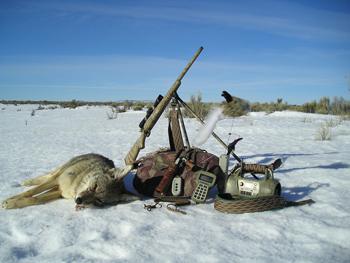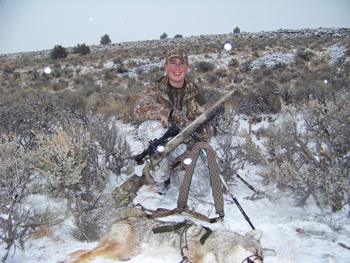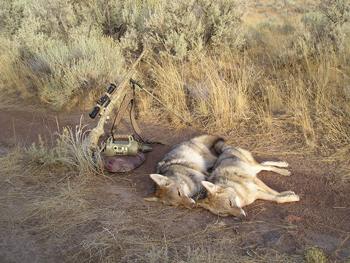Summer Prep for Winter Fur
By Tim Titus
The dog days of summer are prime time to get ready for the upcoming days of chasing prime coyotes in the fall. Soaring temperatures make imagining thick furred predators coming to the call on single digit mornings difficult but now's the time for the serious fur hunter to get ready for a full winter of coyote hunting. Someone once said that success is when opportunity meets preparation. So, what can the serious predator hunter do this time of year to prepare for the opportunities this fall? More than you might think.

The dog days of summer are not just for cleaning rifles and equipment. Although now is a great time to work on that sticky extractor or replace that old heavy factory trigger for the aftermarket trigger you've been wanting. Now is also the time to send that e-caller back to have the charging jack fixed and get the newest upgrades. Maybe you forgot you were going to reprogram your caller to put your most often used sounds up front in the sound list. Now is a good time to look at your overall set-up. Am I ready for a new set of rechargeable batteries and, speaking of that, how about an extra battery holder for the spares? What sound was hardest to master on your handcall? Spend some time working on that sound.
Summer is the time to look at your fur loads also. With the less temperature sensitive Extreme powders, your summer load work is more legitimate than in decades past. Fine tune that load and while you're at the range spend some time with your shooting sticks or bipod polishing your shooting technique. It takes 10,000 repetitions of something to become an expert but all those repetitions don't have to take place with live ammunition. Dry firing will make your muscle memory kick in when the pressure is on and that furred up coyote is coming hard and fast to your call. The hours invested at the range will pay dividends this fur season.
Preparation doesn't end with your rifle though. Maybe you've decided to sharpen your shotgun skills for the coming season. Pattern those loads and see what works best for your gun. Now is the time to find the holes in your pattern not when a coyote with death in his eyes is about to take a bite out of your decoy. A little time at the trap range won't hurt either.
Speaking of shooting, take your predator rifle into the varmint fields. I spent some time this spring with my Savage Predator Hunter .204 and my Stoney Point Rapid Pivot Bipod shooting sagerats (Belding's Ground Squirrels). They are about the size of the cardboard tube from inside a toilet paper roll. It is the same set-up I use for 95% of my winter coyote calling. Was it as effective as it would have been benched up with a two-point rest? No. But, there weren't many shots that weren't minute of coyote either. Again, the trigger time will pay dividends this fall.

Prairie dogs and woodchuck will sharpen your skills as well especially if you set-up like you would on your calling stand. And, don't discount the opportunity to learn something about the terminal performance of your bullet. A good fur load will many times not exit on a big rockchuck or groundhog. Compare what you are seeing on the varmints to a known fur load. (See my article Fur Loads,in the February 2011 edition of the LongRangeHunting.com magazine.) The intel gathered on varmints can still lead you to some valuable conclusions on terminal bullet performance.
Jackrabbits are another target of opportunity that will sharpen your skills with either rifle or shotgun. The cyclic nature of jackrabbit populations make them an unreliable prey but even on down years, they can be found in pockets. Look for them on the roadways while travelling at night then come back during daylight hours for some sporting shooting and great practice. When you are able to kill jacks running through the sage with any regularity at all, the coyotes are in trouble!
No varmints? Head to the hills and do some rock shooting. The dry dirt of summer makes shot calling a breeze. The more time you spend with your fur load, the more automatic trajectory and windage compensations become. And, once that load is developed, why not get some ammo loaded ahead for the coming winter months as well. Stock piling a few favorite components may not be a bad idea either after the supply issues we saw in the last election year.

Firearms and equipment aren't the only uses of the summer season. Think ahead to developing some landowner relations and scouting potential stands for this coming fur season. Combine a family outing or camping trip with some scouting. Continually evaluate stand locations while travelling. Just having coyotes in the area doesn't necessarily mean success unless you have places to hide your vehicle and ways to get into your stand locations undetected. (See the article "Coyote Calling—The Approach". http://www.longrangehunting.com/articles/coyote-calling-approach-1.php. ) Having a list of stand locations in mind prior to fur season will make you more effective later.
Too hot to get out? Spend some time watching last season's reruns of predator hunting shows or watch some of those old predator hunting DVD's again with an eye to coyote body language. Sharpen your ability to read coyotes better. Skip the critiques of the shows or the television character and focus on what the coyote does. Can you predict what is about to happen? When would you take the shot? Nothing takes the place of first-hand experience but a hunter can only get in front of so many coyotes in his or her lifetime. Some video footage can fill the gap when you can't be in the field. Combine that TV time with some dry firing exercises and even the hottest day can be turned into a skill-building event.
Now is also the time to review new equipment becoming available. Is there something out there that can up your odds this coming winter? Any upgrades you need to make? Get familiar with that new equipment before you head into the field. Sitting on stand this fall isn't the time to hope you are ready. Start preparing now and the opportunities you have this winter will translate into success when the mercury drops, your breath crystallizes in your nostrils and the first coyote of the season is responding to your call.
Yeah, that was movement in the sage. A coyote is working across the flat. He's coming steady and, although he doesn't know it yet, he's mine….
Tim Titus has been calling coyotes for 35 years. He lives in the coyote rich country of Southeast Oregon where he and his son spend their winters calling predators and their springs and early summers shooting varmints. Tim owns and operates No Off Season, an on-line predator and varmint hunting store and guiding business. You can check it out at No-Off-Season.com.
Join the discussion of this article HERE at the Article Discussion Forum.
Home
By Tim Titus
The dog days of summer are prime time to get ready for the upcoming days of chasing prime coyotes in the fall. Soaring temperatures make imagining thick furred predators coming to the call on single digit mornings difficult but now's the time for the serious fur hunter to get ready for a full winter of coyote hunting. Someone once said that success is when opportunity meets preparation. So, what can the serious predator hunter do this time of year to prepare for the opportunities this fall? More than you might think.

The dog days of summer are not just for cleaning rifles and equipment. Although now is a great time to work on that sticky extractor or replace that old heavy factory trigger for the aftermarket trigger you've been wanting. Now is also the time to send that e-caller back to have the charging jack fixed and get the newest upgrades. Maybe you forgot you were going to reprogram your caller to put your most often used sounds up front in the sound list. Now is a good time to look at your overall set-up. Am I ready for a new set of rechargeable batteries and, speaking of that, how about an extra battery holder for the spares? What sound was hardest to master on your handcall? Spend some time working on that sound.
Summer is the time to look at your fur loads also. With the less temperature sensitive Extreme powders, your summer load work is more legitimate than in decades past. Fine tune that load and while you're at the range spend some time with your shooting sticks or bipod polishing your shooting technique. It takes 10,000 repetitions of something to become an expert but all those repetitions don't have to take place with live ammunition. Dry firing will make your muscle memory kick in when the pressure is on and that furred up coyote is coming hard and fast to your call. The hours invested at the range will pay dividends this fur season.
Preparation doesn't end with your rifle though. Maybe you've decided to sharpen your shotgun skills for the coming season. Pattern those loads and see what works best for your gun. Now is the time to find the holes in your pattern not when a coyote with death in his eyes is about to take a bite out of your decoy. A little time at the trap range won't hurt either.
Speaking of shooting, take your predator rifle into the varmint fields. I spent some time this spring with my Savage Predator Hunter .204 and my Stoney Point Rapid Pivot Bipod shooting sagerats (Belding's Ground Squirrels). They are about the size of the cardboard tube from inside a toilet paper roll. It is the same set-up I use for 95% of my winter coyote calling. Was it as effective as it would have been benched up with a two-point rest? No. But, there weren't many shots that weren't minute of coyote either. Again, the trigger time will pay dividends this fall.

Prairie dogs and woodchuck will sharpen your skills as well especially if you set-up like you would on your calling stand. And, don't discount the opportunity to learn something about the terminal performance of your bullet. A good fur load will many times not exit on a big rockchuck or groundhog. Compare what you are seeing on the varmints to a known fur load. (See my article Fur Loads,in the February 2011 edition of the LongRangeHunting.com magazine.) The intel gathered on varmints can still lead you to some valuable conclusions on terminal bullet performance.
Jackrabbits are another target of opportunity that will sharpen your skills with either rifle or shotgun. The cyclic nature of jackrabbit populations make them an unreliable prey but even on down years, they can be found in pockets. Look for them on the roadways while travelling at night then come back during daylight hours for some sporting shooting and great practice. When you are able to kill jacks running through the sage with any regularity at all, the coyotes are in trouble!
No varmints? Head to the hills and do some rock shooting. The dry dirt of summer makes shot calling a breeze. The more time you spend with your fur load, the more automatic trajectory and windage compensations become. And, once that load is developed, why not get some ammo loaded ahead for the coming winter months as well. Stock piling a few favorite components may not be a bad idea either after the supply issues we saw in the last election year.

Firearms and equipment aren't the only uses of the summer season. Think ahead to developing some landowner relations and scouting potential stands for this coming fur season. Combine a family outing or camping trip with some scouting. Continually evaluate stand locations while travelling. Just having coyotes in the area doesn't necessarily mean success unless you have places to hide your vehicle and ways to get into your stand locations undetected. (See the article "Coyote Calling—The Approach". http://www.longrangehunting.com/articles/coyote-calling-approach-1.php. ) Having a list of stand locations in mind prior to fur season will make you more effective later.
Too hot to get out? Spend some time watching last season's reruns of predator hunting shows or watch some of those old predator hunting DVD's again with an eye to coyote body language. Sharpen your ability to read coyotes better. Skip the critiques of the shows or the television character and focus on what the coyote does. Can you predict what is about to happen? When would you take the shot? Nothing takes the place of first-hand experience but a hunter can only get in front of so many coyotes in his or her lifetime. Some video footage can fill the gap when you can't be in the field. Combine that TV time with some dry firing exercises and even the hottest day can be turned into a skill-building event.
Now is also the time to review new equipment becoming available. Is there something out there that can up your odds this coming winter? Any upgrades you need to make? Get familiar with that new equipment before you head into the field. Sitting on stand this fall isn't the time to hope you are ready. Start preparing now and the opportunities you have this winter will translate into success when the mercury drops, your breath crystallizes in your nostrils and the first coyote of the season is responding to your call.
Yeah, that was movement in the sage. A coyote is working across the flat. He's coming steady and, although he doesn't know it yet, he's mine….
Tim Titus has been calling coyotes for 35 years. He lives in the coyote rich country of Southeast Oregon where he and his son spend their winters calling predators and their springs and early summers shooting varmints. Tim owns and operates No Off Season, an on-line predator and varmint hunting store and guiding business. You can check it out at No-Off-Season.com.
Join the discussion of this article HERE at the Article Discussion Forum.
Home

